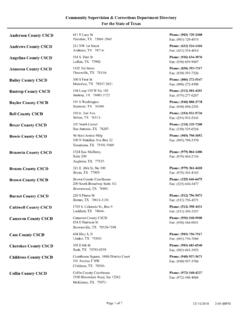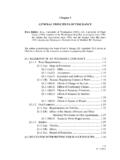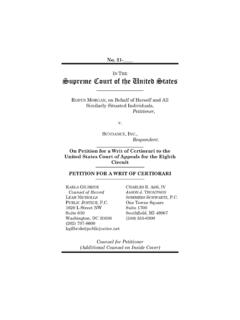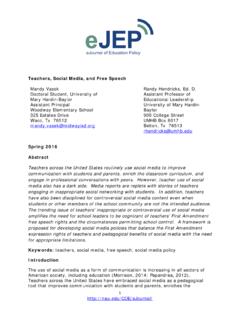Transcription of Timeline: History of Health Reform in the U.S.
1 timeline : History of Health Reform in the VIEW: Early 1900's 1930 1934 1935 1939 1940 - 1945 1945 - 1949 1950 - 1954 1955 - 1959 1960 1964 1965 1969. 1970 - 1974 1975 1979 1980 - 1984 1985 - 1989 1990 1994 1995 - 1999 2000 2004 2005 2009 2010. Early 1900's 1912 1912. Teddy Roosevelt and his National Convention of Insurance Commissioners Progressive party endorse develops first model of state law for regulating Health social insurance as part of insurance. their platform, including Health insurance. 1915. The American Association for Labor Legislation (AALL) publishes a draft bill for compulsory Health insurance and promotes campaigns in several states.
2 A few states show interest, but fail to enact as enters into World War I. The idea draws initial support from the AMA, but by 1920 AMA reverses their position. 1921 1927. Women reformers persuade Congress to pass the Committee on the Costs Sheppard-Towner Act, which provided matching of Medical Care forms to funds to states for prenatal and child Health centers. study the economic Act expires in 1929 and is not reauthorized. organization of medical care. Group is comprised of economists, physicians, public Health specialists, and other major interest groups. Recommendations were completed by 1932. While some members would not support the recommendation for medical group practice, the majority did endorse the idea, along with voluntary Health insurance.
3 1929 1929. baylor Hospital introduces Great Depression years begin. a pre-paid hospital insurance plan for a group of school teachers, which is considered the forerunner of future nonprofit Blue Cross plans. 1930 1934. National Health Insurance and the New Deal Hard economic times called for social policies to secure employment, retirement, and medical care. President Roosevelt appointed a committee to work on all these issues, but in the end did not risk the passage of the Social Security Act to advance national Health Reform . For an overview on National Health Insurance and the New Deal, please see p. 2 of National Health Insurance: A Brief History Of Reform Efforts In The 1929-39 1934.
4 The Great Depression spans a decade, with 1933-34 FDR creates Committee on Economic Security to being the worst years. address old-age and unemployment issues, as well as medical care and insurance. 1935 1939. National Health Insurance and the New Deal President Roosevelt continued to support national Health Reform throughout his terms. His second push for national Health insurance came after the Social Security Act passed. However, the momentum from FDR's Technical Committee on Medical Care and a National Health Conference were not enough to overcome a Congress that was no longer supportive of further government expansions.
5 For an overview on National Health Insurance and the New Deal, please see p. 2 of National Health Insurance: A Brief History Of Reform Efforts In The 1935 1935. Committee on Economic Security issues final Social Security Act recommendations, none of which explicitly address passed by Congress. The national Health insurance; however principles of Act includes grants for Health Reform are outlined. Committee later issues Maternal and Child unpublished report "Risks to Economic Security Health . These grants Arising Out of Illness." restored many of the programs established under the Sheppard- Towner Act and extended the role of the Children's Bureau to include not only maternal and child Health services, but other child welfare services as well.
6 1935 1935-36. FDR forms Interdepartmental Committee to National Health Survey conducted under the auspices Coordinate Health and Welfare Activities. of the Public Health Service to assess the nation's Health and the underlying social and Learn more about the Interdepartmental economic factors affecting Health the forerunner to Committee. the National Health Interview Survey of today. 1937 1938. Technical Committee on Medical Care established National Health Conference convened in Washington, under Interdepartmental Committee to Coordinate Health and Welfare Activities; publishes its report, A. National Health Program in 1938.
7 1939. Sen. Wagner introduces National Health Bill incorporating recommendations from the National Health Conference. Proposal dies in committee. 1939 1939. Physicians start to organize the first Blue Shield plans Department of Health and Human Services born as to cover the costs of physician care. the Federal Security Agency bringing together federal agencies concerned with Health , welfare, and social insurance. 1940 - 1945. 1943 1943. War Labor Board rules wage freeze does not apply to Senators Wagner and Murray, along with fringe benefits, including Health insurance benefits. Representative Dingell introduce legislation as part of broader vision to operate Health insurance as part of social security.
8 Wagner-Murray-Dingell bill includes provisions for universal comprehensive Health insurance along with other changes to social security meant to move toward system of "cradle to grave". social insurance. 1944 1944. FDR outlines 'economic bill of rights' including right Social Security Board calls for compulsory national to adequate medical care and the opportunity to Health insurance as part of the Social Security achieve and enjoy good Health in his State of the system. Union address. Access the text of FDR's 1944 State of the Union address. 1945 - 1949. National Health Insurance and the Fair Deal President Truman picked up the mantle for a national Health program just months after the end of World War II.
9 His election in 1948 appeared to be a mandate for national Health insurance, but the opposition, using fear of socialism, coupled with the power of southern Democrats who believed a federal role in Health care might require desegregation, effectively blocked all proposals. For an overview on National Health Insurance and the Fair Deal, please see p. 3 of National Health Insurance: A Brief History Of Reform Efforts In The 1946 1946. Truman sends Health message to Congress. Revised Hill-Burton Act (Hospital Survey and Construction Wagner-Murray-Dingell bill introduced to Congress Act) to fund the construction of hospitals passes.
10 It again. An alternative Senate bill (Taft-Smith-Ball bill) also prohibits discrimination on the basis of race, authorizes grants to states for medical care of the religion, or national origin in the provision of hospital poor. Neither bill gains traction. services, but allowed for "separate but equal". facilities. The statute also required hospitals to provide a "reasonable volume" of charitable care. 1947 1948. Truman, in another special message to Congress National Health Assembly convened in Washington, calls for a National Health Program. Wagner-Murray- , by the Federal Security Agency. Final report Dingell bill and Taft bill both reintroduced.







